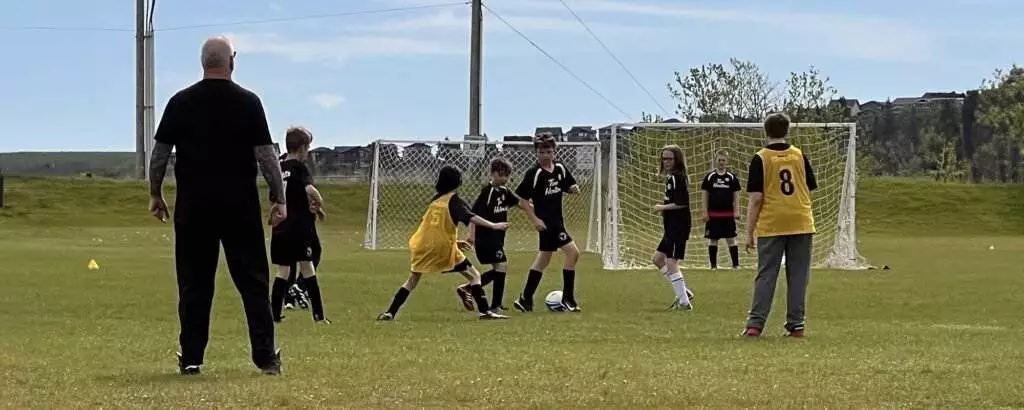At Cochrane Wolves FC, we believe that understanding and mastering game tactics and strategies are as important as developing technical skills. While individual talent can shine in soccer, it’s the team that wins the game. Effective tactics and strategies ensure that players work together harmoniously, making the most of their collective strengths. In this blog post, we’ll explore how young players can improve their soccer game tactics and strategy, covering both basic and advanced concepts. We’ll also delve into different formations and their uses, providing a comprehensive guide for players, parents, and coaches.
Understanding the Basics: Foundation of Soccer Tactics
1. Understanding Positions and Roles
Before diving into tactics, players need to understand the different positions on the field and the specific roles associated with each. Here’s a brief overview:
- Goalkeeper (GK): The last line of defense, responsible for preventing the ball from entering the goal.
- Defenders (DF): Including center-backs, full-backs, and wing-backs, they prevent the opposing team from scoring and support the build-up play from the back.
- Midfielders (MF): Central, defensive, and attacking midfielders link the defense and attack, controlling the flow of the game.
- Forwards (FW): Strikers and wingers are primarily responsible for scoring goals and creating offensive opportunities.
Understanding these positions and their responsibilities is the first step in learning soccer tactics.
2. Basic Soccer Tactics
Possession Play
Possession play focuses on maintaining control of the ball, building up play patiently, and waiting for the right moment to attack. Key aspects include:
- Short Passing: Emphasizing accurate and quick short passes to maintain possession.
- Movement Off the Ball: Players must constantly move to create passing options, making it harder for opponents to intercept.
Counter-Attacking
Counter-attacking tactics involve quickly transitioning from defense to attack after winning the ball. This requires:
- Speed: Fast players who can exploit spaces left by the opponent’s attack.
- Direct Passing: Long passes to quickly move the ball forward.
Advanced Tactics: Elevating Game Strategy
1. Pressing
Pressing involves applying pressure on the opponent high up the pitch to win the ball back quickly. There are different pressing strategies:
- High Press: Applying pressure deep in the opponent’s half, forcing them to make mistakes.
- Midfield Press: Pressing in the middle third to win the ball and launch attacks from a stronger position.
- Low Block: Defending deep in your half, inviting the opponent to come forward and then breaking quickly.
2. Playing Out from the Back
Playing out from the back involves building up play from the goalkeeper and defenders, rather than opting for long balls. This requires:
- Composure: Defenders and the goalkeeper must remain calm under pressure.
- Spacing: Proper spacing between players to create passing lanes and avoid pressing traps.
3. Overlapping Runs
Overlapping runs are typically used by full-backs to create width and overloads on the flanks. This tactic involves:
- Timing: The full-back must time their run perfectly to receive the ball in space.
- Coordination: The winger needs to know when to cut inside, allowing the full-back to overlap.
Different Formations and Their Uses
1. The 4-4-2 Formation
One of the most traditional formations, the 4-4-2, features:
- Four Defenders: Two center-backs and two full-backs.
- Four Midfielders: Two central midfielders and two wide midfielders.
- Two Forwards: Two strikers.
Use: This formation provides a balanced structure, suitable for both attacking and defensive play. It’s simple and easy for young players to understand.
2. The 4-3-3 Formation
The 4-3-3 formation is known for its attacking prowess, with:
- Four Defenders: Similar to the 4-4-2.
- Three Midfielders: Usually consisting of one defensive midfielder and two central midfielders.
- Three Forwards: A central striker supported by two wingers.
Use: Ideal for teams that emphasize possession and attacking play. It allows for width and depth in the attack.
3. The 3-5-2 Formation
The 3-5-2 formation includes:
- Three Defenders: Often three center-backs.
- Five Midfielders: Including wing-backs who operate along the flanks and can drop back to form a five-man defense.
- Two Forwards: Two strikers working in tandem.
Use: This formation provides defensive solidity and midfield dominance. It’s versatile and can be adapted to both defensive and attacking styles.
4. The 4-2-3-1 Formation
A modern favorite, the 4-2-3-1, features:
- Four Defenders: Standard back four.
- Two Defensive Midfielders: Providing a shield in front of the defense.
- Three Attacking Midfielders: Supporting the lone striker.
- One Forward: A central striker.
Use: This formation offers a balance between defense and attack, with a solid midfield presence and creative freedom for the attacking midfielders.
Implementing Tactics at Cochrane Wolves FC
At Cochrane Wolves FC, we incorporate these tactics and formations into our training sessions to ensure our players are well-rounded and tactically aware. Here’s how we do it:
1. Training Sessions
Our training sessions are designed to introduce and reinforce both basic and advanced tactics. Through drills and simulated game situations, players learn to apply these strategies in real-time.
2. Video Analysis
We use video analysis to help players understand tactical concepts better. Reviewing footage of professional games and our own matches allows players to see tactics in action and understand their implementation.
3. Tactical Discussions
We hold regular tactical discussions with our players, encouraging them to think critically about the game. Understanding why certain tactics are used in specific situations helps them make better decisions on the field.
4. Match Day Execution
On match days, we emphasize the importance of executing game plans. Players are encouraged to communicate and adjust tactics as needed based on the flow of the game.
Conclusion: Elevating Soccer IQ at Cochrane Wolves FC
Improving soccer game tactics and strategy is a continuous journey. At Cochrane Wolves FC, we are committed to developing players who are not only technically skilled but also tactically astute. By understanding and applying both basic and advanced tactics, our players can enhance their game intelligence and performance.
We encourage parents and guardians to support their young athletes by fostering an environment that values learning and growth. Watching games together, discussing tactics, and encouraging strategic thinking can significantly contribute to a player’s development.
Thank you for being a part of the Cochrane Wolves FC community. Together, we can help our players reach new heights in their soccer journey, one tactic at a time!





